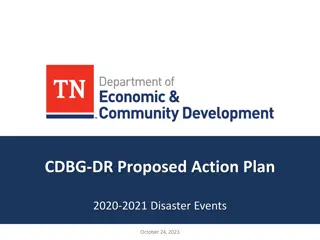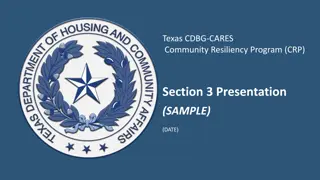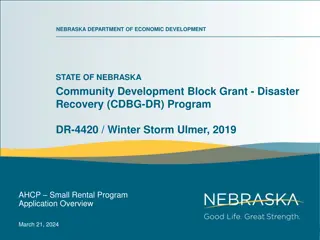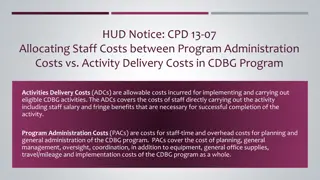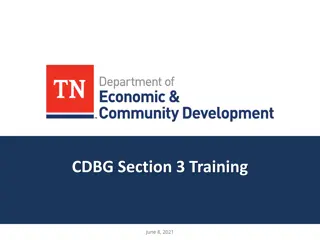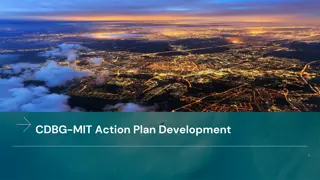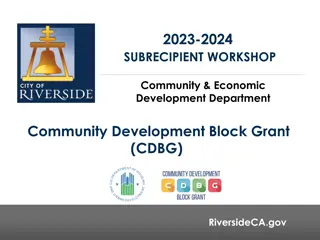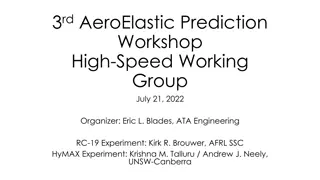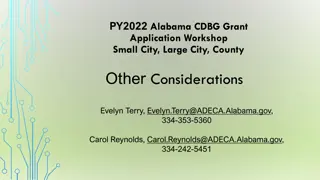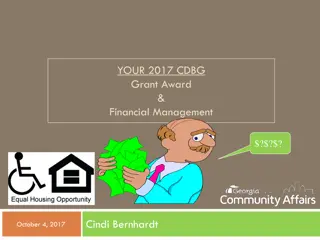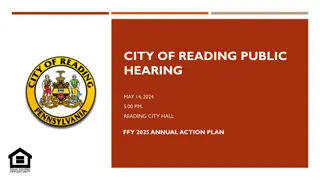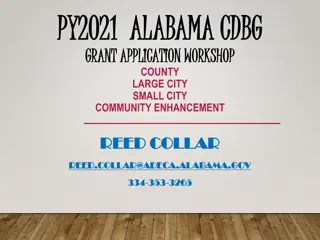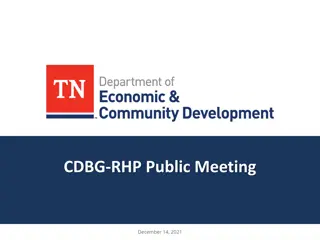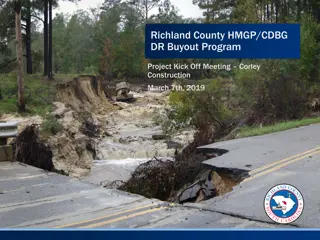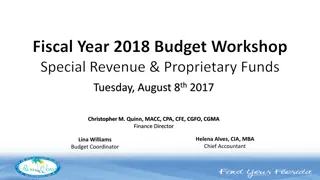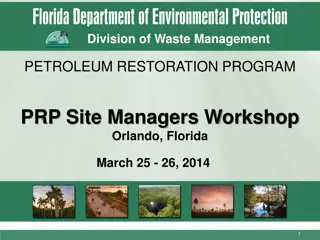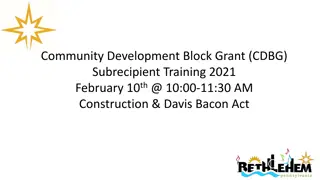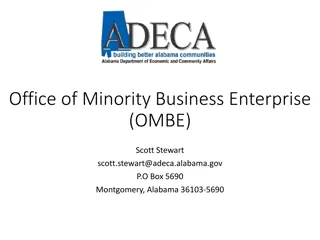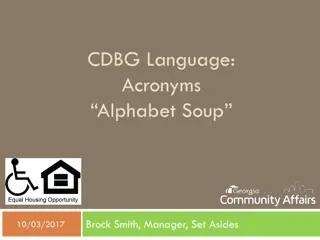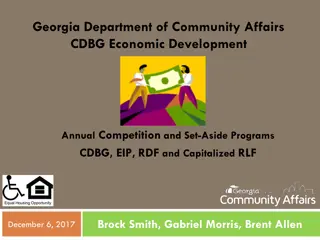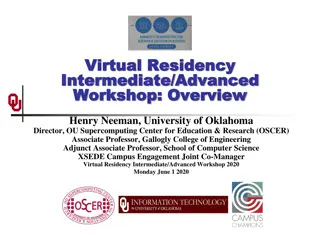CDBG Application Workshop
This document provides comprehensive information on the CDBG Application Workshop for the 2018 Regular Round taking place on December 7, 2017. It includes details on the staff members involved, the schedule of important dates, the online process along with attachments, jurisdictional calculations options, and guidelines for beneficiary information listing. The content covers key aspects of the application process, deadlines, and procedures to follow.
Download Presentation

Please find below an Image/Link to download the presentation.
The content on the website is provided AS IS for your information and personal use only. It may not be sold, licensed, or shared on other websites without obtaining consent from the author.If you encounter any issues during the download, it is possible that the publisher has removed the file from their server.
You are allowed to download the files provided on this website for personal or commercial use, subject to the condition that they are used lawfully. All files are the property of their respective owners.
The content on the website is provided AS IS for your information and personal use only. It may not be sold, licensed, or shared on other websites without obtaining consent from the author.
E N D
Presentation Transcript
CDBG Application Workshop 2018 Regular Round December 7, 2017
Staff Amy New: Assistant Commissioner, Rural Development Brooxie Carlton: Deputy Assistant Commissioner Kent Archer: CDBG Director Corrine Wiesmueller: Program Manager Joe Slaughter: Resiliency Coordinator Karla Nicodemus: Program Coordinator Jamie Bedgood: Grants Analyst Rice Pritchard: Grants Analyst Lee Peterson: Grants Analyst Lindsay Gainous: ARC Coordinator
Schedule Priority List letters due January 19, 2018 Public Meetings held by January 24, 2018 Final change orders due January 24, 2018 Final RFPs due February 2, 2018 Closeouts due February 9, 2018 Applications due February 23, 2018
Process Online with attachments - all documents will by the end of next week Jurisdiction calculations will be in Excel this year Allows for more automation Still using the FTP site for uploads Ability-to-Pay will remain the same Use this and the Application Notices (to be published in the coming weeks) as a guide NOTE: If any information is inconsistent, the information in the Application Notices will supersede.
Jurisdictional Calculations Six different options Single Jurisdiction (Direct Beneficiary) Single Jurisdiction (Indirect Beneficiary) Multi-jurisdiction, One County (Direct Beneficiary) Multi-jurisdiction, One County (Indirect Beneficiary) Multi-jurisdiction, Multiple County (Direct Beneficiary) Multi-jurisdiction, Multiple County (Indirect Beneficiary) Read instructions on each sheet Information can only be entered in blue fields Sheets to be completed are in green Reference and informational sheets are in black
Title Page No big changes here Total will be auto-calculated ATP is auto-filled based on the first entry on the Beneficiary sheet Can still digitally sign
Beneficiary Information List the applicant jurisdiction first List subsequent jurisdictions in order of greatest to least beneficiaries Each jurisdiction must be qualify through Census or Survey This will drive PCI calculations LMI calculations will auto-fill for indirect; must be manually entered for direct Project Impact calculations will show at the bottom If MJ do not double count population NOTE: Contact ECD for anything other than city or county (i.e. Census Tract)
PCI Worksheet Operates the same as last year PCI and points will auto-calculate PCI points for Census will be the same for 2015 and 2018 Community Need score will show at bottom
PCI Calculations (MJ only) No information is entered on this page Everything auto-calculates Information is dependent on Beneficiary sheet Weights PCI points based on Census or Survey and percentage of beneficiaries
Unemployment Rate (MJ multi-county only) Similar to PCI Calculations No information is entered on this page Everything auto-calculates Information is dependent on Beneficiary sheet Weights UE points based on percentage of beneficiaries
TASS Nothing new here Complete the sheet based on the target surveys A separate TASS must be completed for each target area plus and overall TASS Follow the directions on the sheet to create a copy
Racial Breakdown This has been altered to separate race and ethnicity Hispanic is not a race The total of Hispanic and Non-Hispanic should equal the racial total Enter the values for all races, not just minorities
LMI Breakdown Nothing new here either 30% may not be available if using Census
Map Survey Form Totals will auto calculate at top Use the one form for all target areas Complete all fields for each line
Rate Factor This is dependent on the Beneficiary sheet Rate factor will now be calculated off the Census PCI Utility rate is all that needs to be entered
Online Application Working on multi-user function General items stay the same Application information Project Funding Brief project description One or two sentences Think about the contract scope All attachments are at the end
Application Program Narrative This is where project details should be provided What the project will accomplish, and what problem will be solved? Note anything unusual Tell us how this fits with prior projects, other current projects, and any projects in the future (not only CDBG) show that you are strategic Benefit to minorities and national objectives are separate questions Be specific describing economic development Lost employment Sites passed over Inability to expand Provide backup documentation
Application Performance Measures This is a new section Provide at least one measurable output and outcome to be measured over the life of the project While scoring is not affected, these are required Output - This is a measure of the direct result of the grant funds. (Examples: LF of water line replaced, number of fire trucks purchased, etc.) Outcome - This is a quantitative measure of how the project is impacting a goal of the community. (Examples: reduction in water loss, improvement in emergency response time, etc.)
Application HCD Needs, Surveying, & Construction Information Thoroughly explain the needs of your community Point to studies or plans if available Housing must be addressed Think about vulnerable and disadvantaged populations Select how the application meets LMI Tell month and year surveys were conducted Length of construction in months Will full-time or part-time inspection be required?
Additional Documents The CDBG Anti-displacement Plan is a separate document 2018 Budget Template (discussed later) Disclosure Report (HUD-2880) No to both questions Remember to check box at the top of the page Download the appropriate Jurisdiction Calculation Workbook
Additional Documents Procurement letters Use up-to-date letters Send to firms with a reasonable expectation to do the work Jurisdiction maps Show project location (similar to ERR maps) Show target areas Show jurisdictional boundaries Minority maps Not needed for system-wide projects; make sure to note Important for DB applications; scale should be appropriate Show project location
Additional Documents Resolutions looked better last year Avoid exact match amounts if able Utility Letters Must be filled out and signed by the Utility Manager Even if the system is owned by the city, the utility manager needs to sign Still base the rates on 5,000 gallons of water/wastewater Include taxes and fees where applicable
Public Meetings 2 ads for the application meeting, one at least 14 days before the meeting Should be a display ad (stands out) Should be in the legal section if possible Include statement of non-discrimination Also add information about the meeting to the city/county website and make (and document) other attempts to reach out to minorities
Public Meetings Timeline: Public meeting then engineer procurement and resolution Schedule to maximize participation You must document feedback in the minutes Explain the CDBG process and ask for potential projects
Supplemental Questions Will be better tailored to project type If under a TDEC enforcement action describe how the project will move you toward compliance Community Livability Don t be repetitive, but provide concise detail Provide backup documentation Prove the problem and solution Clearly show the need of the project Explore alternatives or explain why there is none
PERs Please make sure the budget matches the application Does not need to be lengthy need to know why this project in the context of their system, other options considered, budget We will have additional guidance in the Application Notices related to PERs for Sewer System projects
Specific Projects Water Lines Need a list of samples that is legible Double check the letter from the sampler to make sure all information is included Need to be able to match the map to the MSF Test 35% for the best score Have to test at least one HH in each target area and at least 10% in each target area Sewer Lines If you are extending a sewer line to a school or other facility, call us first to make sure the survey process is done correctly If there is a sewer use ordinance (that will be enforced) then it doesn t matter how they answer the TAS questions Include all homes and structures on the map
Specific Projects Water and Sewer Systems Priority List Letters are due February 2, 2018 Submit sooner than later Save a copy of submission Choose either plant or collection for sewer system projects they will be ranked separately Make sure the PER matches the application Include brief information on moratoriums, violations, consent decrees, etc. Include documentation How does this project improve the situation?
Specific Projects Community Livability Use numbers whenever possible in the Supplemental Questions Use 2-3 years of calls and amount of loss Insurance savings for a home should be based on a $150,000 house Provide detail to separate an application from the pack Number of calls, Property loss, ISO improvement, Age of truck Maintenance records DON T ASSUME WE KNOW
Specific Projects Housing How do you choose houses need, who will complete survey, something else? Getting better about doing the number of houses you say you are going to do, but this still needs work Try to concentrate target area
General Information Formatting Naming Convention same Just list what the document is brief list name of doc then city/county name No subfolders No spaces before you start typing Reapplying Procurement is good for 2 years Indirect beneficiary surveys are good for 3 years (adjust to new PCI intervals) Direct beneficiary surveys need to be done every year Public meetings and resolutions need to be done every year
Scoring Changes Project Impact Rate factor will now use Census PCI Will increase from 20 to 25 points Sewer System Collection Points for planning and enforcement actions System plans & management plans 5 points Commissioner s Order 20 points Director s Order 15 points Consent Decree/Agreed Order 10 points Moratorium Only 5 points Sewer Line Extension Reducing Project Need to 70 points Community Livability Split into large and small population Split will be at 5,000 people
Budget Template This template is intended to evenly distribute match Can still overmatch line items Takes into account additional funding Backup detail feeds budget line items Other Engineering Prof. Fees Capital Purchase Other Non-Personnel Other Non-personnel only line item that can attribute all, none, or some cost to grant
Budget Template CDBG amounts entered; total and match auto-calculated Calculator at the bottom can assist in determining CDBG amount $1,500 is the max for Environmental Review Tab included to help with Engineering costs Should be reasonably close to the engineering schedule Most projects will be considered simple Will clarify project types for simple and complex Construction inspection costs revised Full-time: $10,000 per month of construction Part-time: $6,500 per month of construction Instructions are included in the first tab
Kent Archer (615) 354-3591 kent.archer@tn.gov


